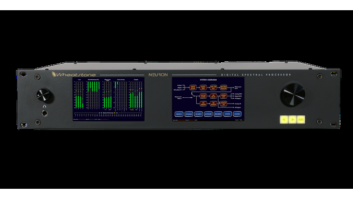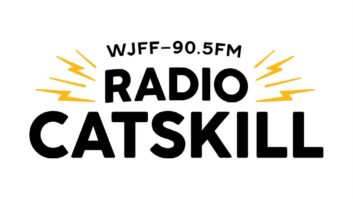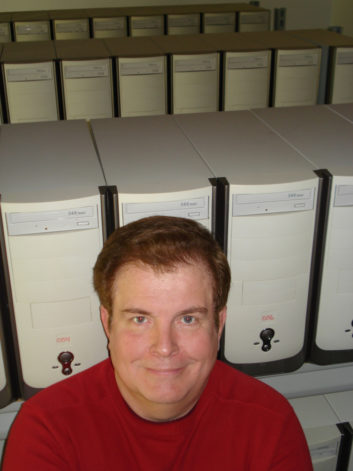
This article was originally published in Radio World Engineering Extra in 2007. In remembrance of Glen Clark’s passing, we are sharing it again today.
Today’s broadcasting buzzword is “digital.”
There wasn’t much that was digital back in the early 1980s. However in 1981, an engineer from Sharon, Pa., developed the innovative “digitally controlled” Texar Audio Prism and changed audio processing. During the 1980s, any station looking for the loudest processing combination would have Texar Prisms and an Orban 8100 in its racks.
I met Glen Clark back in 1982 when he personally delivered a pair of Texar Prisms to me in Providence, R.I., then set them up using only a Simpson 260 VOM and the Prism’s internal pink noise generator. I was impressed by both Clark and the Audio Prism.
He first became interested in radio in the eighth grade, and that interest grew into Texar Inc., a company he founded in Pittsburgh. He later sold Texar to Gentner and started Clarkcom, a consulting firm that now specializes in computer-designed AM directional-antenna patterns.
Clarkcom has designed some of the most challenging AM directional upgrades in the country including WWJ, WFDF and WXYT in Detroit; WCBM and WWLG in Baltimore; WMVP, Chicago; and WMAL and WMET in Washington.
For fun, Clark also uses his supercomputer — yes, he owns one — to dabble in stock market trading. He takes us back to the “loudness wars” of the 1980s and what led to the development of the Texar Audio Prism.
Radio World: What was your first job in radio?
Glen Clark: I did the sign-off shift at WGRP(AM) in Greenville, Pa., when I was 16.
RW: When did you get interested in audio processing?
Clark: At WLS(AM), Chicago, in 1972. ABC had just moved its Chicago FM O&O — then called WDAI(FM) — from Marina Towers to the newly-completed John Hancock Building. WDAI was getting pounded into the ground by CBS’s WBBM(FM) and a few others. Keep in mind that, in 1972, there was no Optimod and the hot box for FM audio processing was the CBS Volumax II — the slim-line unit.
WDAI was where I first started looking at the overshoot in the anti-aliasing filters in the RCA stereo generator and at peak-to-average ratios.
After I left WLS in 1974 to go back to school and finish my degree, I spent a summer working with Eric Small [who was marketing Orban’s early on-air processors to broadcasters], carrying around the original, hand-wired, perf-board prototype of the Optimod 8000. I installed it as a demo at WFBQ(FM) in Indianapolis and at several of the ABC FM O&Os for Alan Shaw. The usual reaction was that everyone wanted to keep the demo unit until we could replace it with a production unit. Sometimes it was hard to get the demo unit back.
RW: What is the story behind the development of the Texar Audio Prism?
Clark: The whole reason to go back to school was to understand the math of the non-ringing filters that Bob Orban had in the Optimod. But when I graduated I ended up back in a line engineering
function as the group director of engineering for the Post-Gazette stations based in Pittsburgh. Dealing with the day-to-day hurly burly of a bunch of rock FM stations and news/talk AM stations was a lot more exciting than watching traces on an oscilloscope for days on end, which is what designing audio processors is all about.
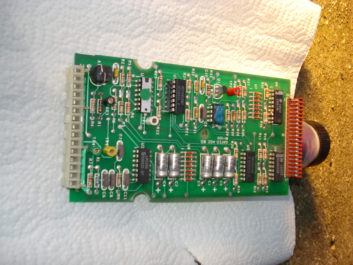
There were three people who were instrumental in the chain of events that led to the Audio Prism. None of them ever knew the part they played.
Diane Sutter had just been appointed general manager of WPEZ(FM), which was the Post-Gazette’s flagship FM station in Pittsburgh. Bobby Christian was the program director for WXKX(FM) 96-KIX, Hearst’s FM rocker on the other side of town. And the late Ron Jones was the president of CRL, the other renegade processor manufacturer of the day.
At the time, about 1980, the Optimod 8100 hadn’t yet been released. The hot audio chain at the time was a pair of Dorrough DAP-310s feeding an Optimod 8000 driving a Collins/Rockwell 310-Z exciter. If you really knew your craft, you pulled the input filter out of the exciter to minimize overshoot.
One morning the sky fell in. 96-KIX was just jumping out of the dial. We and the other FMs in town looked small by comparison. At first, we were certain that they were simply over-modulating. But an off-air measurement showed them to be completely legal. Some spy work by a weekend disk jockey revealed that 96-KIX had a secret weapon, a brand-new audio processor from a company in Phoenix that we had never heard of called CRL.
We made a call to Phoenix, placed an order and got on the list of people who would get CRL hardware when our number came to the top of the list. But every time that we thought we were getting near the top of the list, CRL told us we were still several weeks from delivery. When other stations who had ordered CRLs after we did received their product, and we didn’t, Diane Sutter, the WPEZ general manager, thundered, “We’ve been a weak signal compared to 96-KIX for months! If CRL won’t send us equipment, go buy this audio processor thing from someone else!”
I explained that audio processing wasn’t like buying carpet, where you had a dozen vendors to pick from. Audio processing was a small, niche market with few vendors and unequal technology. So I had the unpleasant task of telling Diane, “There is no ‘something else.’ We can’t buy anything from anyone else that will make us sound as loud on the dial.”
RW: What was her response?
Clark: Diane was a take-no-prisoners kind of manager. And she wasn’t about to be embarrassed by Hearst’s 96-KIX, which she had just left to come work for WPEZ.
There are certain moments in all of our lives that will be forever burned into our memories. And this moment will always be burned into my memory. When I told Diane that no one else sells a louder processor, without missing a beat Diane thundered, “Then build one!!” She pivoted on one heel and was gone.
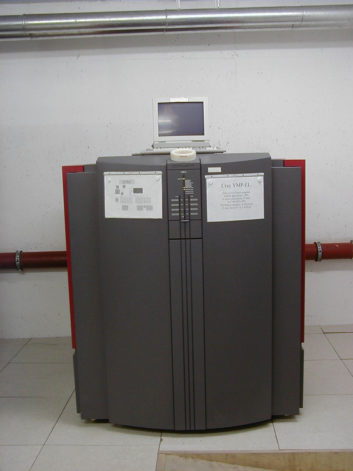
Diane was a sales person through and through. I seriously doubt that if you put an Optimod and a 45 kW Onan generator in front of Diane she could tell which one was the audio processor. And I wondered at the time if she really understood the impact of what she had just said.
But those were in the days before accountants and bankers ran the radio business. You could move a lot of money around from one budget account to another as long as your total budget matched your promises.
Three days later I gave Diane a list of what I needed to “roll our own” processor and Diane, bless her heart, was good on her word. She signed the papers and handed them back to me. All she said was, “I want it done yesterday!”
A month later we had two stone age-looking four-band audio processors ready for their shakedown voyage. Each one took up about 6 inches of rack space. We didn’t even test them as a system before we put them on the air. There wasn’t time. We jammed in the patch cords and hit the air three hours before the Arbitron started.
A few months later a rumor surfaced that the reason WPEZ couldn’t get CRL to ship to us was that Bobby Christian, 96-KIX’s PD, had worked with Ron Jones at KUPD(FM) in Tempe, Ariz. Ron was protecting his buddy Bobby by not shipping any more CRL product to Pittsburgh, the rumor went. I don’t know if the rumors were true. But what is true is that if CRL had shipped an FM stereo processor to WPEZ in 1980, there would never have been a Texar (see Fig. 1).
Pittsburgh is not a Top 10 market. But it does have a lot of vehicle traffic passing through with the Pennsylvania Turnpike connecting Baltimore, Washington and Philadelphia to the east, with Detroit, Chicago and Denver to the west. We started getting calls at WPEZ from broadcasters driving through on the Turnpike and asking what kind of processing we were running. A few months later I worked out a deal with WPEZ to own the designs in return for other consideration and went into the manufacturing business. That was 1981.
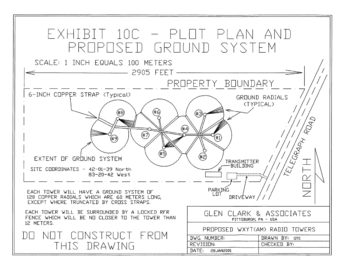
RW: Why did you make a career change after the Prism?
Clark: The Texar booth had been close to the Gentner booth at several NAB and SBE conventions. Russ Gentner was looking to make some acquisitions so that he would be big enough to “go public.” Russ had let it be known during some casual conversations in the aisle at several of the shows that, if I ever wanted to sell, he might want to buy.
I had just finished the design for the Texar Lazer — the analog version, not the digital version — and was at a logical breakpoint. The Lazer was an integrated FM limiter and stereo generator. For the first time, Texar had an end-to-end product line. You didn’t have to co-op with another brand of hardware.
What I didn’t count on was that the FCC would make the NRSC-1 guidelines for occupied bandwidth mandatory 30 days after Russ and I signed the deal. Every AM station in the country had an FCC-mandated timeline to get NRSC-1 compliant equipment installed. My guesstimate is that Texar would have dropped $2 million to the bottom line in the next 18 months on the NRSC products alone.
RW: What do you think about the state of audio processing today?
Clark: Game over. The great modulation wars of 25 years ago are over.
When I was in Chicago in 1972, the peak flasher on the Belar mod monitor would flicker at 100 percent while the RMS meter would bounce wildly around 70 percent. In 1980, the flasher was still flickering at 100 percent and the meter was waving around 80 percent. By 1990, the Belar meter looked like it was painted on at 90 percent. It never moved except when the announcer stopped to take a breath.
Where is there to go? You already have loudness and clarity. What could a new processor offer the market?
Today, people take the processor out of the box, put it in the rack, spend three days deciding which preset works best for their format and then forget about it.
RW: Did you have a mentor or someone who helped you get started in your career?
Clark: The hands-on skills I learned for working with AM arrays came from the late John Mullaney, Jack’s father. But there were few mentors available for working on FM problems. I would characterize solving FM problems more as collaboration than mentoring.
The gray lions knew AM inside out. But, in the very early 1970s, FM was not a force in the ratings and few people had paid much attention to anything more than just keeping the transmitter on the air and putting background music on the channel. The ins and outs of working with FM were fresh snow with no footprints in it.
Most of what we take for granted today was still unknown in 1972. Aligning cart machines with an X-Y scope so that you didn’t lose the high end on mono receivers was still a black art. And no one knew then what the impact of synchronous AM noise was on fringe reception at the time.
When I was in Chicago, my two main collaborators, mostly by telephone, were Eric Small and Bob Deitsch. Eric had just left WXLO(FM) in New York to start an audio consulting firm. And Bob had been hired by ABC to be the chief engineer of WPLJ(FM) in New York at the same time I was hired at WLS.
A dozen years later, after Texar had opened its doors, Bud Aiello, Jeff Gulick, Jeff Keith and Frank Foti were important sounding boards for new ideas. Bud, Jeff and Jeff were chief engineers for stations here in Pittsburgh. And group owner Malrite had just moved Frank Foti from San Francisco to WHTZ(FM) Z100 in New York.
Bud is now with NPR in Washington. Jeff Keith recently moved from Omnia to Wheatstone. Jeff Gulick, sadly, died last year of a rare form of cancer. And Frank has, of course, gone on to be the chief wizard for the Omnia line of audio processors.
RW: Can you tell us about one of your more challenging projects these days?
Clark: My time today is split evenly between playing the stock market and designing directional antennas.
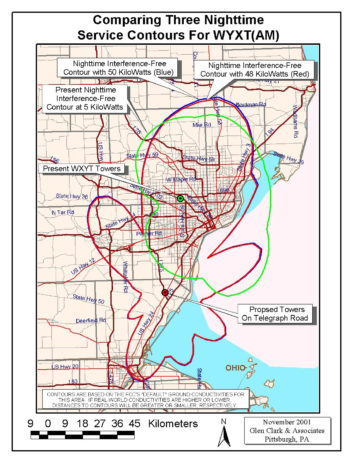
Something I became interested in while at Purdue in 1974 was the supercomputer. Purdue had a pair of CDC 6600 computers, the last computer that Seymour Cray designed before he left CDC to go start his own company. The 6600 was the supercomputer of the time (see Fig. 2).
Several years earlier, a former MIT math professor named Edward O. Thorp wrote a book called “Beat the Dealer.”
In preparation for writing the book, Thorp had run tens of thousands of imaginary hands of the card game blackjack on an IBM 704 computer and come up with a set of rules of when to fold and when to hold, based on what cards were left in the deck.
The publication of Thorp’s book was the beginning of the science now known as “card counting.” If you sit down at a blackjack table at the Bellagio during the NAB convention, they deal multiple decks from a “shoe.” You have Professor Thorp to thank for that. The shoe and the multiple deck deal were both in response to Thorp’s book.
A few years after writing “Beat the Dealer,” Thorp suggested that large computers also could be used to find patterns in the stock market. Thorp left academia, stopped writing books, opened a hedge fund, moved to Newport Beach, Calif., and, by one account, owns the most expensive house in Orange Country; no small accomplishment.
I had always wanted to apply digital signal processing techniques and large computers to Thorp’s ideas. But Texar was a never-ending sprint to come up with new designs, so there was no time to explore the stock market during the Texar years.
A few years after selling Texar, I bought a used Cray YMP-EL supercomputer from a defense contractor in Texas that was upgrading to a larger model. I’ve used the Cray to design about a dozen 50 kW power upgrades for AM stations around the country. One of the designs, a nine-tower we did for CBS in Detroit, has been the subject of an ongoing discussion in a number of blogs. The arrangement of the towers is, shall we say, unconventional. (See Figs. 3 and 4)
But the real goal with the supercomputer has always been to explore Professor Thorp’s premise that, with a big enough computer, you can consistently beat the stock market. Three years ago, I retired the Cray and replaced it with a 100-node cluster computer (Fig. 5).
A lot of the cluster’s time is still spent redesigning AM arrays to broadband them in preparation for HD Radio. But when it is not busy on an antenna project, it is sifting through reams of stock market data, looking for patterns that predict, a day in advance, when a stock will go up or when it will go down. That day of advance warning gives us time to buy stock options.
Some people have asked how someone could go from audio processors to antenna design to stock market trading. But it’s all just math. It would amaze people if they knew how similar the equations are for an antenna and for a non-ringing audio filter. And all the science you need to beat the stock market is inside an Omnia audio processor.
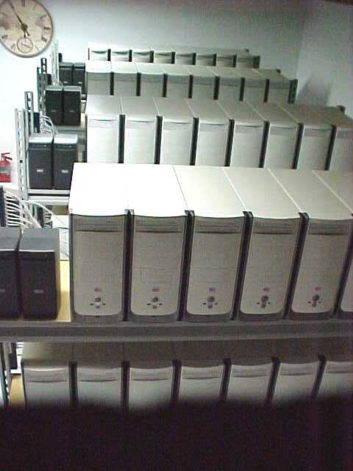
RW: What do you think the future of AM and FM IBOC is?
Clark: Harder question than the last one. Everyone thought that the “must have” application for HD was going to be digital clarity. But it is turning out to be HD-2. Two high-quality distribution channels for almost the same price as you used to pay for one channel? Not bad. And a bunch of new receivers have found their way into mainstream distribution channels in the last few months. But the flip side of the equation is that Apple announced on April 10 that it had just sold its 100 millionth iPod.
A man is climbing up a ladder on the side of a boat that is sinking. Is he getting further from the water or closer to the water? Hard to tell. That may not be so much a statement about HD as it is a statement about the plurality of alternative distribution channels, which have come online recently.
There were several years when the prevailing wisdom was that XM and Sirius would spell the end of AM and FM radio. But I am far more worried today about Verizon’s FiOS fiber-to-the-home service.
No, FiOS won’t give you traffic advisories of whether to take the upper or lower level of the George Washington Bridge into Manhattan. But it sure will let you load a lot of music on your iPod before you leave home. And an iPod port is a far easier option to find in an auto dealership showroom today than an HD Radio option.
RW: What do you do when you’re not working?
Clark: I love to water ski. There is nothing like making a J-turn around a slalom buoy at 50 mph with your right hip and your right elbow skimming the water’s surface and throwing a 50-foot-high “rooster-tail” wake that people can see from the other end of the lake. Some friends say that skydiving is a bigger adrenaline rush. But I’m afraid of heights.
RW: What do you want to be doing ten years from now?
Clark: Dating Reese Witherspoon. But, even though she and Ryan split up, I still can’t get her to call me back.
I think that stock market trading is endgame for me. Texar was fun when it was about solving puzzles. How do you handle the bass punch of Queen’s “Fat Bottom Girls” without punching a hole in the mid-range? Directional antennas are still an interesting puzzle. How do you put a westward nighttime null from Detroit to protect the 950 kHz in Chicago without putting a null across Interstate-75, Detroit’s lifeline to the world? But I don’t know how many years AM has left.
Stock trading and options trading are pure math puzzles. The puzzle is always changing and the profit potential is gigantic. Once I get Reese Witherspoon to marry me, I can’t imagine anything
I would rather be doing than trading options.
Steve Callahan is a frequent contributor to Radio World Engineering Extra.





